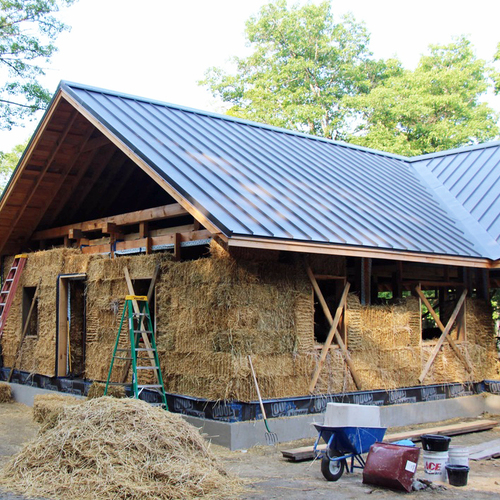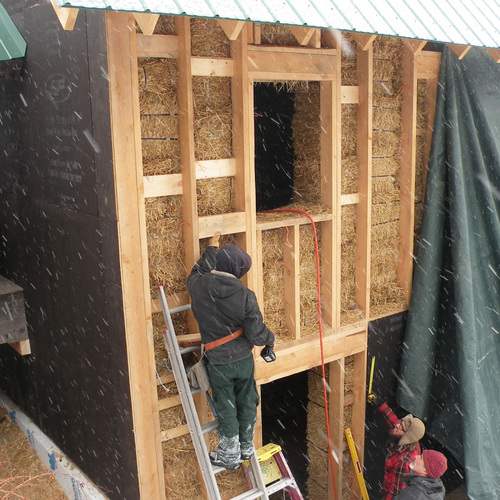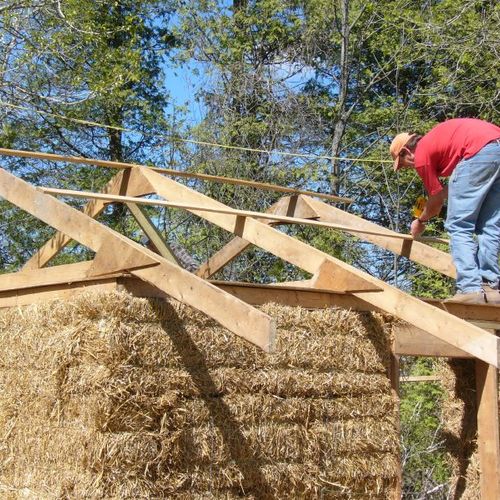
Image Credit: Ferut Arhchitects (images 1 and 2); Franciscan Earth Literacy Center (images 3, 4, and 5)
Image Credit: Ferut Arhchitects (images 1 and 2); Franciscan Earth Literacy Center (images 3, 4, and 5) The straw-bale walls of Little Portion Green are designed to provide R-50 thermal resistance. Installating Millcell insulation in the foundation bed, in early October. Little Portion Green last November. The roof was on by mid-December.
Ohio has turned out to be a busy place for projects aspiring to exemplary energy efficiency, including Passivhaus performance. A three-bedroom, 1,800-sq.-ft. home near Dayton was completed in 2010 and since has been Passivhaus-certified. And a 2,500-sq.-ft. home is being built to the standard on the grounds of the Cleveland Museum of Natural History, which will display the house as part of “Climate Change,” a nationally touring exhibit scheduled for display at the museum from July 23 through December 31.
Another project focused on energy efficiency – a straw-bale house under construction in Tiffin, Ohio – should be completed in the coming months. It is a 1,500-sq.-ft. two-bedroom house being built by the Sisters of St. Francis of Tiffin, whose mission includes elder care, health care, education, and ministries in Mexico. The overall aim of the project is to spread the word that an energy-efficient home can be comfortable, affordable (despite the cost of straw-bale construction), and easy on the planet. Little Portion Green, as the house is called, is intended to inspire construction of energy-efficient homes in Seneca County and serve as model for straw-bale construction done well.
“We want this facility to be attractive,” Mike Conner, chief of the Earth Literacy Center, a ministry of the Sisters of St. Francis in Tiffin, told the Toledo Blade after the project got underway last fall. “We want people when they see it to go, ‘Wow. How’d they do that? I want to do something like that.’ ”
Salvaged materials, local straw
The project is being financed through Sisters of St. Francis fund-raising initiatives, whose success largely determines the pace of construction. As of November, the cost estimate for the project was about $100,000, and the hope is the house will be completed in time for the Ohio Solar Tour, a statewide open-house presentation scheduled for October 2 and 3.
Conner told GBA that fundraising has gone well, and that the $100,000 estimate for the construction of the house is holding up. Separate funding that had been lined up for a photovoltaic system and wind turbine has fallen through, however, and so the project team has set its fundraising goals beyond the original $100,000 budget.
As the Blade story notes, Little Portion Green’s construction is being managed by Sister Jane Omlor, whose past credits include the construction of a straw-bale chapel in West Virginia. She is expected to be Little Portion Green’s first tenant.
Ferut Architects, based in Elyria, and Passivhaus-design specialist HarvestBuild Associates, in Columbia Station, are providing the technical guidance for the building, which resembles a small Ohio farmhouse. The metal roof is made from recycled steel, and salvaged items are used for interior fixtures, including doors, hardware, railings, and other fittings. The underside of the concrete slab is insulated with Millcell, a foam-like material made in Germany from recycled glass.
HarvestBuild principal Mark Hoberecht told GBA that the approximate R-values will be 30 for the foundation, 50 for the walls, and 70 for the roof. The house will be equipped with Loewen triple-pane windows and an UltimateAir RecoupAerator energy-recovery ventilator. Hoberecht also noted that the original ambition for the project was to build it to the Passivhaus standard, “but the floor plan doesn’t lend itself very well to maximizing the Treated Floor Area (thereby minimizing the heating loads per square foot), and with their funding uncertainty, the higher cost of better windows just didn’t fit into their budget.”
He also explained that because the project relies fairly heavily on volunteer labor, properly addressing all of the necessary Passivhaus details would have been cost-prohibitive. “They’re about half-way through construction,” he added, “and looking back, we made the right decision to not pursue Passive House certification.”
Weekly Newsletter
Get building science and energy efficiency advice, plus special offers, in your inbox.















10 Comments
Millcell
Any one have any more info or thoughts on this Millcell material? I hadn't heard of it before.
I tried too, Matthew
Online: a few comments about it and a link to an English version of a very sketchy (I mean no detail) German website. Lots of vague claims, but I'm sure there's more to it.
Better news: I checked out the Loewen windows and there's a rep. just a few miles away. They have considereable detail and I'm wondering why I've never heard of them.
Joe W
Loewen Windows
Hey Joe, I have used Loewen windows. I think they are the best wood windows I have ever had my hands on, which includes most. NO rep in my area:>(
Loewen does triple glazing
Joe,
Loewen sells triple-glazed windows -- including triple-glazed windows with clear glazing (not low-e) if you want the highest possible SHGC.
triple glazing
Loewen is a favorite among many architects in Minnesota because of their slender profile.
Correct me if I am wrong but I am assuming the sash of the triple-glazed windows for Loewen, like the domestic tripane sashes, is not at the optimal thickness for lowering the u-value. Loewen is a bit more spendy than Marvin typically so if you are considering Loewen triple pane you are getting near the price point of the better performing German wood/clad options - Optiwin, Energate, Pazen.
“but the floor plan doesn't
I don't understand this quote. It is more difficult to achieve Passivhaus energy limits the smaller the structure gets but R-30 foundation, R-50 walls and R-70 roofs seem adequate for Ohio. Like they said maybe the windows are the limiting factor.
I think this is an attractive home from the exterior (though the bumpout seems to unnecessarily complicate the logic of the wall assembly) and I am a fan of earth plaster on bale.
However I wonder if the use here of the straw bale is forced. The structure is light frame wood assembly and the straw bales I assume only furr the insulation inward on the first floor which represents about a third of the overall envelope. Straw bale don't make good gable walls or dormers. I'd love to be on site to witness the construction to see what the implications will be of adding a straw layer to the inside.
Regardless I bet this is a great experience for everyone involved.
Forced
What material use isn't forced?
forced
Matthew,
What I mean by forced is the entire above grade assembly is light frame construction deep enough to accommodate a generous fill of cellulose. Why not use this approach uniform throughout? I would argue it would reduce cost but this project is engaging volunteer labor.
I'm sure there is an element of community engagement that is involved here and the use of the straw bales solidifies that aspect for this project. Again it looks to me like a great project but I'm throwing questions out whether it could serve as a model for better building practices.
If they did stick with a cellulose filled deep assembly though they would loose the affect of the earthen plaster finish on the bales with deep set windows wells. This could be quite nice. Again I'd love to see pics of the project in progress and when complete.
J Chestnut
I can see your point, but I believe they are using the bales in a volunteer friendly way. Having built a lot with bales, people mistake the method for easy or simple, not really the case. By using the bales to "boost" there insulation assembly, and eliminating the structural shear bale detailing, they are avoiding the use of foam, and gaining the irregular interior surface to beautify with earth plaster. I agree that bales do not handle rake walls or gable walls in general.
straw bale
Thank you very much for the article. So pleased to find this blog and will be sure to share it with our friends. The Franciscan Earth Literacy Center has been working on this project for several years. The project manager is Sister Jane Frances Omlor. These ladies were green before being green was cool. Their green initiatives include their Seeds of Hope Farm, which grows chemical-free produce. tiffinfranciscans.org for more information. And visit us on Facebook at Franciscan Earth Literacy Center. -- Kate Oatis, director of communications, Sisters of St. Francis, Tiffin
Log in or create an account to post a comment.
Sign up Log in